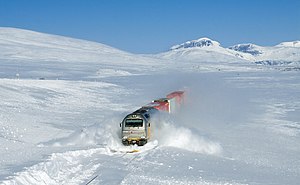
Back Sneeu Afrikaans Schnee ALS አመዳይ Amharic Nieu AN Snāw ANG Ìbot awo ANN बर्फ ANP ثلج Arabic تلج ARY تلج ARZ
| Snow | |
|---|---|
 Norwegian train plowing through drifted snow | |
| Physical properties | |
| Density (ρ) | 0.1–0.8 g/cm3 |
| Mechanical properties | |
| Tensile strength (σt) | 1.5–3.5 kPa[1] |
| Compressive strength (σc) | 3–7 MPa[1] |
| Thermal properties | |
| Melting temperature (Tm) | 0 °C |
| Thermal conductivity (k) For densities 0.1 to 0.5 g/cm3 | 0.05–0.7 W/(K·m) |
| Electrical properties | |
| Dielectric constant (εr) For dry snow density 0.1 to 0.9 g/cm3 | 1–3.2 |
| The physical properties of snow vary considerably from event to event, sample to sample, and over time. | |
| Part of a series on |
| Weather |
|---|
|
|
Snow comprises individual ice crystals that grow while suspended in the atmosphere—usually within clouds—and then fall, accumulating on the ground where they undergo further changes.[2] It consists of frozen crystalline water throughout its life cycle, starting when, under suitable conditions, the ice crystals form in the atmosphere, increase to millimeter size, precipitate and accumulate on surfaces, then metamorphose in place, and ultimately melt, slide or sublimate away.
Snowstorms organize and develop by feeding on sources of atmospheric moisture and cold air. Snowflakes nucleate around particles in the atmosphere by attracting supercooled water droplets, which freeze in hexagonal-shaped crystals. Snowflakes take on a variety of shapes, basic among these are platelets, needles, columns and rime. As snow accumulates into a snowpack, it may blow into drifts. Over time, accumulated snow metamorphoses, by sintering, sublimation and freeze-thaw. Where the climate is cold enough for year-to-year accumulation, a glacier may form. Otherwise, snow typically melts seasonally, causing runoff into streams and rivers and recharging groundwater.
Major snow-prone areas include the polar regions, the northernmost half of the Northern Hemisphere and mountainous regions worldwide with sufficient moisture and cold temperatures. In the Southern Hemisphere, snow is confined primarily to mountainous areas, apart from Antarctica.[3]
Snow affects such human activities as transportation: creating the need for keeping roadways, wings, and windows clear; agriculture: providing water to crops and safeguarding livestock; sports such as skiing, snowboarding, and snowmachine travel; and warfare. Snow affects ecosystems, as well, by providing an insulating layer during winter under which plants and animals are able to survive the cold.[1]
- ^ a b c Michael P. Bishop; Helgi Björnsson; Wilfried Haeberli; Johannes Oerlemans; John F. Shroder; Martyn Tranter (2011), Singh, Vijay P.; Singh, Pratap; Haritashya, Umesh K. (eds.), Encyclopedia of Snow, Ice and Glaciers, Springer Science & Business Media, p. 1253, ISBN 978-90-481-2641-5
- ^ Hobbs, Peter V. (2010). Ice Physics. Oxford: Oxford University Press. p. 856. ISBN 978-0199587711.
- ^ Rees, W. Gareth (2005). Remote Sensing of Snow and Ice. CRC Press. p. 312. ISBN 978-1-4200-2374-9.